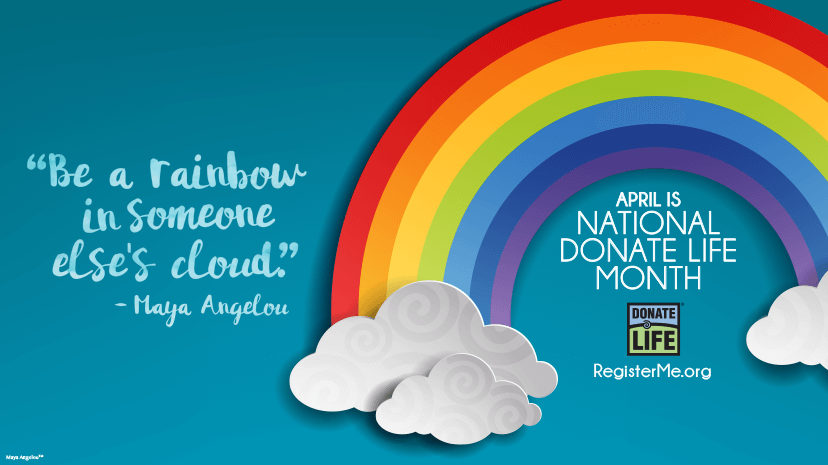 April is a big month for an important but difficult topic to discuss: organ donation. The goal of the Donate Life program is to educate others about organ donation, to get you to have the tough conversations with your family about it, and to hopefully get more people to register as donors. The theme of 2018’s Donate Life month is from Maya Angelou: “Be a rainbow in someone else’s cloud.” We have all seen those brilliant rainbows that come after a storm or hard rain, and overall the rainbow is a sign of optimism in the darkness. This is exactly why the quote was perfect to spread the message about giving the gift of life.
April is a big month for an important but difficult topic to discuss: organ donation. The goal of the Donate Life program is to educate others about organ donation, to get you to have the tough conversations with your family about it, and to hopefully get more people to register as donors. The theme of 2018’s Donate Life month is from Maya Angelou: “Be a rainbow in someone else’s cloud.” We have all seen those brilliant rainbows that come after a storm or hard rain, and overall the rainbow is a sign of optimism in the darkness. This is exactly why the quote was perfect to spread the message about giving the gift of life.
Some Statistics from Donate Life
Did you know that about 115,000 people, including children, are awaiting organ donation right now? Over 80% of those are awaiting a kidney donation. Every year, 8,000 people will die because they didn’t get an organ donation, or about 20 people a day. These are sad statistics, but the reality is each of us is likely connected to organ donation in some way. It might be that we know someone waiting for a transplant, someone who received a transplant, or someone who was a donor. Organ donation is so much more prevalent than is thought – in fact since there is over a half-million transplants that have happened since the procedures became more commonplace in the late 1980s. Someone who is an organ donor can save up to 8 lives. If they also agree to donate their eyes and tissue, they can make a difference in the lives of up to 80 people.
Types of Organ Donation
Most people only know about deceased donation. Deceased donation is when the organs, eyes, or tissues of a person who has passed away are donated to others. While the end of a life is always tragic, the ability to help others is a rainbow after the storm. However, most people do not know about the option of living donation. Living donation is when a living person donates a kidney, or a portion of their liver, to someone on the transplant list. These are the best quality organs and typically allow the recipient to get an organ donation much faster.
In the past, living donation really only happened among family members. However, now almost 25% of living organ donation comes from someone besides a family member. 82% of those who need a transplant need a kidney, and 13% need a liver. That means the vast majority of organ donation could be living donation! Bone marrow transplants also provide hope for many children and adults with leukemia. Most people do not realize that living donation is an option, though, so they don’t get tested. Often it is only when an organ need is posted through social media or news sources do people go to get tested for living organ donation. But, it is coming more well-known. In fact, in 2015, there were 6,000 living organ donations. To learn more about living organ donation, or how you could become involved, check out their website.
Things you can do
There are lots of things you can do for organ donation awareness month. The student council at Bay View Middle School puts on the “NEW Donate Life Walk.” You can register for the walk or check our their silent auction items! For more information, click here.
You can also contribute to organ donation research through the Donate Life webpage. Or, help to educate others about organ donation. You can even register to be a living donor or a bone marrow transplant donor. One of the best things you can do is also take care of your body to help lower the need for organ donation.
Finally, are you currently signed up to be an organ donor? If so, it is important to have that conversation with your family. This can be a difficult topic, but if these conversations have been had, your family can rest assured that your wishes are being fulfilled while being able to avoid difficult conversation for your family later.

















